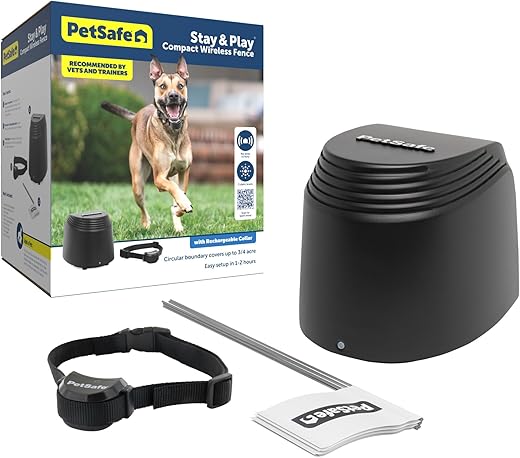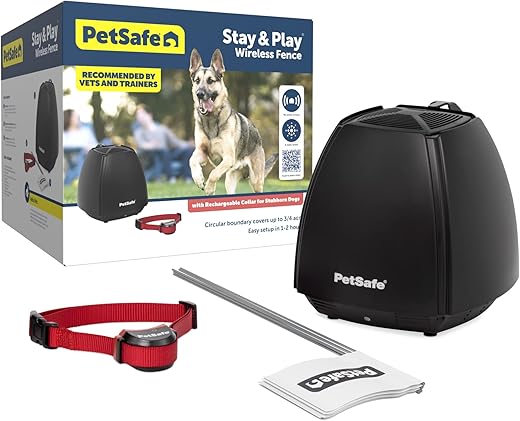This step-by-step guide offers users of the PetSafe Wireless Fence System a comprehensive approach to identify and resolve interference issues that can disrupt the system’s performance. It begins by outlining common sources of interference, such as electronic devices and environmental factors, and provides practical troubleshooting tips to minimize these impacts. Users will learn how to adjust transmitter settings, reposition the base unit, and check for physical obstructions, ensuring a reliable and effective containment solution for their pets. By following these steps, pet owners can restore consistent functionality to their wireless fence system and maintain a safe perimeter for their furry companions.
How to Address Signal Interference with Your Wireless Dog Fence
Identify the Source of Interference
Walk around the area where the wireless fence is set up. Look for potential sources of interference that may disrupt the signal. Focus on the following types of items:
- Electronic Devices: Identify any nearby electronic devices, such as microwaves, cordless phones, or Wi-Fi routers. These devices often operate on similar frequencies and can cause interference.
- Radio Towers: Observe if there are any radio transmission towers in proximity. Their powerful signals can disrupt the functionality of your wireless fence.
- Large Metal Objects: Look for large metal structures, such as fences, cars, or storage sheds. Metal can reflect signals and create dead zones in your wireless coverage.
Note any devices or structures that may be operating on similar frequencies. Record their locations and frequency ranges if possible. This information will help in diagnosing interference issues and making necessary adjustments to your wireless fence system.
Check the Transmitter Placement
Place the transmitter in an open area to ensure optimal performance. Avoid positioning it near walls, which can obstruct the signal, or close to large appliances that may interfere with the transmission. Select a spot where the transmitter has a clear line of sight to the area you wish to cover, maximizing its reach and minimizing obstacles.
Adjust the height of the transmitter if necessary, as elevating it can further enhance signal strength. Keep it away from other electronic devices, such as microwaves or cordless phones, that may cause interference. Regularly check the placement and make adjustments to maintain effective coverage, especially if you notice a drop in signal strength or connectivity issues.
Inspect the Receiver Collar
Examine the pet’s receiver collar for any signs of wear or damage. Look for frayed edges, cracks, or corrosion on the contacts, as these can affect its performance. Check the battery by opening the compartment and assessing its condition; if it appears low or depleted, replace it with a new one that is compatible with the device.
Ensure the collar is snug but not too tight. Place two fingers between the collar and your pet’s neck; if you can fit them comfortably, the collar is likely at the right tightness. Adjust the collar as needed to prevent it from slipping off or causing discomfort. Regularly inspect the collar to maintain its effectiveness and keep your pet safe.
Adjust the Boundary Settings
Review the boundary settings on your transmitter by accessing the configuration menu. Locate the sensitivity settings, which typically allow you to increase or decrease the transmitter’s response to signals. Adjust the sensitivity level upwards to see if it improves the performance and reduces interference. If the system allows, also explore any additional options related to filtering or noise reduction, as these can further enhance stability.
Test the system after making adjustments to evaluate if the issues remain. Observe the performance closely, paying attention to any changes in connectivity or signal quality. If interference persists, consider returning to the settings and making incremental adjustments until you find the optimal configuration. Repeat the testing process after each change to ensure that you are moving in the right direction.
Eliminate Other Electronic Devices
Turn off nearby electronic devices like Wi-Fi routers, cordless phones, and baby monitors to troubleshoot potential interference sources. Unplug these devices from their power sources or disable their functionality for a short period. After switching them off, observe whether the interference problem resolves.
If the issue improves, consider relocating these devices to a different area of your home or adjusting their settings. For instance, change the channel on your Wi-Fi router to reduce overlap with other signals or switch to a different frequency band. This can help minimize interference and create a clearer signal for your primary device.
Consult the Manual or Customer Support
Consult the manual for specific troubleshooting steps regarding interference issues. Look for sections that address common problems and solutions. Follow these guidelines:
- Identify the cause of interference by checking for nearby electronic devices that may disrupt the signal.
- Adjust the placement of the transmitter unit to ensure it is in an optimal location, away from walls and large metal objects.
- Ensure the receiver collar is charged and functioning properly, as low battery levels can affect performance.
Contact customer support if the interference persists after applying the manual’s recommendations. Gather relevant information before reaching out, including:
- Model number of your PetSafe Wireless Fence System.
- Description of the issue and the steps you have already taken.
- Any error messages or unusual signs displayed on the system.
By providing detailed information, you can receive tailored assistance that may resolve the interference issue more effectively.
Final Tips for Resolution
In conclusion, addressing interference with your PetSafe Wireless Fence System is essential for ensuring your pets’ safety and freedom. By systematically identifying potential sources of interference, inspecting your equipment, and making the required adjustments, you can enhance the system’s performance. With these steps, you’ll be well on your way to a reliable and effective wireless fence solution. Keep your pets secure and enjoy peace of mind knowing they’re protected.







Hey everyone! Just wanted to share my experience with the PetSafe Wireless Fence System. We had a lot of issues with interference because of our neighbor’s Wi-Fi router. Once we moved the transmitter a bit further from the house, it worked way better! Also, make sure to double-check the collar batteries; I found that a weak battery can really mess things up. Hope this helps someone!
Thanks for sharing your experience! Transmitter placement can definitely make a big difference. It’s great to hear that moving it helped you out. And yes, battery checks are crucial! Keep it up!
I have the PetSafe Stay & Play Wireless Fence and found that using a GPS collar as a backup has worked wonders for me. Anyone else tried this? Would love to know if others have variations that have worked well!
That’s an interesting approach! A GPS collar can definitely enhance safety and tracking. It’s awesome to hear how you’ve adapted your setup. Others, feel free to share your variations too!
I followed the steps in this guide, and my dog is now happily playing within the boundaries without any issues! It took a bit of tweaking, but now it works perfectly. Thanks for the great tips!
So glad to hear that it worked for you! It’s always rewarding when you can find a solution after some effort. Enjoy your time with your pup!
Does anyone have specific recommendations for which electronic devices to eliminate first? I have a lot of gadgets at home and I’m not sure where to start!
Great question! Start by looking for devices that operate on similar frequencies, like microwaves or cordless phones. Those are often the culprits. Good luck!
Tip for everyone: When you set up your PetSafe Wireless Fence, try to keep the area clear of any large trees or bushes. They can block the signal and cause interference. I learned this the hard way!
Thanks for the tip! Keeping the area clear is a smart move. It definitely helps maintain a consistent signal. Appreciate you sharing that!
I’ve tried following the guide, but my dog still gets zapped even when he’s within the boundary! What should I do? I’m really frustrated right now!
Sorry to hear you’re having issues! It could be the collar settings or even the boundary settings not being calibrated right. Try adjusting the collar’s sensitivity and recheck the boundary line. If that doesn’t help, reaching out to customer support might be your best bet.